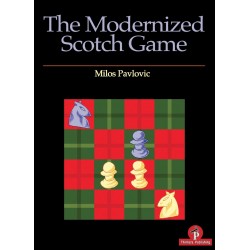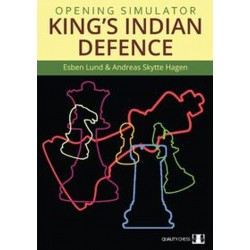No products
Catalog
New products
-

Pendrive "KING" 64GB (A-62/or)
Nice USB memory stick in the shape of a kingMaterial: wood /...
14,00 € -

1400 Chess Puzzless - Mating Combinations - R. Czajkowski, A. Nowicki (K-6254)
Introduction Chess is one of the most difficult and beautiful games man...
25,00 € -

Chessboard No. 6, plastic folding in 4, white and brown (S-212/br)
Tournament size chessboard No. 6 made of plastic, double folded to save...
8,95 € -

Chessboard No. 4, plastic folding in 4, white and brown (S-211)
Tournament size chessboard No. 4 made of plastic, double folded to save...
7,45 € -

Tournament chess ser No. 6 folding mahogany intarsia (S-16/M)
Professional chess set in tournament size No.6. Inlaid chessboard, with...
66,95 € -

Tournament chess ser No. 5 folding mahogany intarsia (S-12/M)
Professional chess set in tournament size No.5. Inlaid chessboard, with...
62,95 € -

Magnetic wooden chess MINI (S-140/M)
Wooden, magnetic perfect as a travel companion in MINI version (S-140/M)
25,45 € -

-

Wooden chessboard No. 5 / tournament standard (S-8/z)
Wooden chessboard Light beige/dark brown fields made by screen printing...
28,00 € -

Turbo-Charge your Tactics 1. Drive Your Improvement - V. Grabinsky, M. Oleksiyenko (K-6358/1)
Turbo-Charge Your Tactics 1 is essentially a chess puzzle book, but not...
26,36 € -

Turbo-Charge your Tactics 2. Accelerate and win - V. Grabinsky, M. Oleksiyenko (K-6358/2)
Turbo-Charge Your TacticsTurbo-Charge Your Tactics 2 concludes a...
26,36 € -

Chess Coach - Vladimir Barsky (K-6355)
A LIFE DEDICATED TO CHESS AND ITS PLAYERS This remarkable book is a...
29,95 €
-

The killer Dutch - Simon Williams (K-3296/kd)
Grandmaster Simon Williams has played...
19,96 € -20% 24,95 €
Openings There are 238 products.
Grivas Opening Laboratory - Vol. 7 -...
The author presents a full opening repertory for the club player, which is analysed in seven volumes. In the books you will find many novelties for both sides, with a full move-to-move presentation. Furthermore, the reader will get access to middlegame strategies, endgame techniques and common tactical motifs, which are patterning the proposed variations.
12,48 € 24,95 € -50%Reduced price!Joshua Doknjas - Opening Repertoire: The...
The Ruy Lopez is perhaps the most classical of all chess openings. It dates back to the 16th century and has featured in the opening repertoire of every modern world champion. It is a highly flexible variation: Bobby Fischer used it to create numerous powerful strategic masterpieces.
21,56 € 26,95 € -20%Reduced price!Priyadharshan Kannappan - The Modernized...
This book’s journey began on the first day of January 2018 when one of my New Year resolutions was to write a chess book. The journey has been very long, but certainly fun, and has in many ways made me understand myself better, both as a person and as a chess player!
19,96 € 24,95 € -20%Reduced price!H. Grooten - Understanding before Moving...
After the first two volumes of the series had been produced (the first about Ruy Lopez and Italian structures after 1.e4 e5, the second about Queen’s Gambit structures after 1.d4 d5), it was time for me to consider the third volume.
25,56 € 31,95 € -20%Reduced price!Nikolai Kalinichenko - The Club Player's...
This is no ordinary opening book. This practical guide describes only such openings in which White or Black sacrifices material at an early stage of the game. They are called gambits (in Old Italian, gambetto means tripping).
14,97 € 24,95 € -40%Reduced price!Milos Pavlovic - The Modernized Scotch...
The Scotch was one of the first modern openings to appear in tournament practice. The nature of the Scotch fitted perfectly into the 19th century era of Romantic chess – the opening’s emphasis on opening lines, fast development, rapid centralisation and, most importantly, fast attacking chances, meshed seamlessly with the style of the day. In a stylistic...
20,76 € 25,95 € -20%Reduced price!Larry Kaufman - Kaufman's New Repertoire...
Kaufman's New Repertoire for Black and White: A Complete, Sound and User-friendly Chess Opening Repertoire
23,96 € 29,95 € -20%Reduced price!David Vigorito - Playing the Najdorf (K-5747)
The Sicilian Najdorf is one of Black’s best and most combative responses to 1.e4. The Najdorf was championed by Fischer and Kasparov during their respective periods of dominance over the world chess scene, and has been used extensively by many other World Champions and elite GMs, including Anand, Gelfand, Topalov and Vachier-Lagrave to name but a few.
22,39 € 27,99 € -20%Reduced price!Ускоренная дебютная подготовка. Дебюты за...
В этой книге представлены редкие и интересные дебютные варианты (за чёрных), которые призваны быстро подготовить вас к партии или соревнованию. Также вы сможете познакомиться с ловушками, теоретическими новинками и оригинальными анализами действующего гроссмейстера. Здесь вы найдёте и позиции для решения, которые помогут улучшить вашу тактическую...
9,99 € 12,49 € -20%Reduced price!A. Khalifman, S. Soloviov - The Modern...
The Scotch Game is the most “open” of all the Open Games. In fact this is the only really Open Game, in its essence, which matches the traditional terminology.
19,60 € 24,50 € -20%Reduced price!Opening Simulator - King's Indian Defence...
The King’s Indian Defence is a popular opening at all levels. Fischer, Kasparov, Bronstein, Nunn, Radjabov and Nakamura are just a few of the many leading GMs who have played it successfully.
22,39 € 27,99 € -20%Reduced price!Cyrus Lakdawala - "Opening Repertoire: 1...
These days the move 1 d4 is often used as the precursor to quieter opening choices such as the London System, the Colle System or the Trompovsky. In this book the highly experienced chess author and coach Cyrus Lakdawala goes back to basics, outlining an aggressive repertoire for White based on 1 d4, following up with the traditional 2 c4.
19,16 € 23,95 € -20%Reduced price!A. Mikhalchishin, G. Mohr - Understanding...
Using carefully selected examples, the authors want to make you familiar with the strategic ideas behind the famous Maroczy bind. These plans arising from both colors, are a must for your arsenal of chess knowledge and understanding.
22,36 € 27,95 € -20%Reduced price!Antonios Pavlidis - The Sicilian Taimanov:...
The Sicilian Taimanov arises after the opening moves 1.e4 c5 2.Nf3 e6 3.d4 cxd4 4.Nxd4 Nc6, and is an ideal weapon for Black in the modern era. It is theoretically sound, and strikes a perfect balance between solidity and dynamic counterattacking potential, which makes it a popular choice among club players and top grandmasters alike.
22,39 € 27,99 € -20%Reduced price!Alessio de Santis - The Hippopotamus...
The Hippopotamus Defence is just what a club player needs. It’s a straightforward and clear-cut chess opening that avoids the ever growing body of mainline theory. It’s universal: Black can use the Hippo against virtually all of White’s choices (1.e4, 1.d4, 1.c4, 1.f4, the Colle, London, Trompowsky, Réti and others). It’s not very well known and will...
23,96 € 29,95 € -20%Reduced price!J. Konikowski, R. Ullrich - The King's...
Any player who prefers to rely on main lines will be weil acquainted with the problem of the sheer masses of opening theory. And as they do not stop growing, there's always the risk that sooner or later they will grow over one's head.
17,20 € 21,50 € -20%Reduced price!Cyrus Lakdawala - Opening Repertoire: The...
The Modern Defence is an opening that will appeal to player of an experimental nature. Black allows White to establish an apparently impressive position in the centre. The plan is to use this structure as a target – it will be restrained, undermined and eventually destroyed.
18,00 € 22,50 € -20%Reduced price!Damian Lemos - Opening Repertoire: The...
Grandmaster Damian Lemos presents a repertoire for White in the Queen’s Gambit, one of the most famous chess openings. The Queen’s Gambit enjoys a long and illustrious past. It has been played by virtually all the strongest grandmasters in the history of chess, and today it remains a popular choice for players of all levels.
19,76 € 21,95 € -10%Reduced price!Jerzy Konikowski, Uwe Bekemann - "Openings...
What does a chess player need who is familiar with the rules, but often gets into trouble right away in the opening? This question was the starting point for the authors before they began to compile their material. The result is a book that gives explanations to help the reader understand the Sicilian Defense – and instructions to show him how to use it.
15,84 € 19,80 € -20%Reduced price!Cyrus Lakdawala - "Opening Repertoire: The...
The French Defence provides a good choice for players who want to create a dynamic, unbalanced situation out of the opening, but baulk at the level of study required to master the ferociously complex Sicilian Defence.
19,16 € 23,95 € -20%Reduced price!Boris Avrukh - Grandmaster Repertoire 2B -...
When Boris Avrukh released his 1.d4 repertoire books in 2008 and 2010, they caused a sensation. GM Michael Adams remarked that “The high-quality Grandmaster Repertoire series has taken this format to a completely different level.” Avrukh’s newly revamped 1.d4 series has raised the bar even higher.
23,99 € 29,99 € -20%Reduced price!The Sicilian Taimanov - Nigel Davies (K-6131)
The Sicilian Taimanov (1 e4 c5 2 Nf3 e6 3 d4 cxd4 4 Nxd4 Nc6) is a very flexible Black system in the Sicilian Defence developed by Mark Taimanov. It is characterised by the development of the g8-knight on e7, often along with a quick ...b7-b5. The Taimanov often leads to tense, dynamic position which are ripe in counterattacking possibilities.
21,15 € 23,50 € -10%Reduced price!G. Burgess "Chess Opening traps for kids"...
Chess becomes fun when we learn how to survive the opening and stop falling into our opponents’ cheap tactical tricks. And that’s what this book is about! By understanding opening play and how to exploit tactical ideas, we turn the tables on our opponents. Now they will be the ones getting outmanoeuvred, tricked, trapped and pushed off the board!
11,96 € 14,95 € -20%Reduced price!Opening Repertoire: The Sicilian Najdorf -...
The Najdorf Sicilian is one of Black’s most respected and popular responses to 1 e4. It was favoured by those two titans of the game, Bobby Fischer and Garry Kasparov and in the modern game it features in the repertoire of many elite players.
19,16 € 23,95 € -20%Reduced price!




























